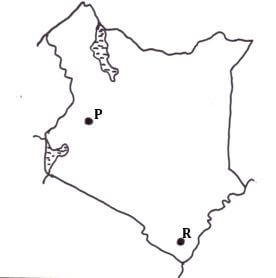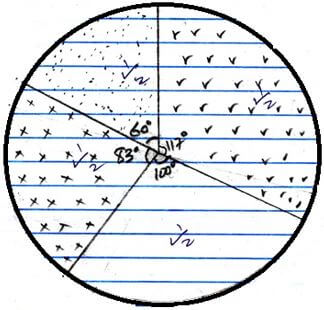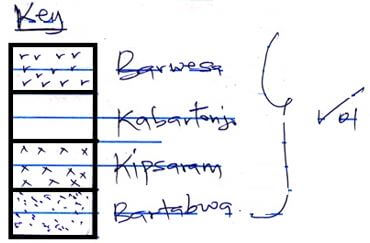INSTRUCTIONS TO STUDENTS
- This paper has two sections A and B
- Answer ALL the questions in section A.
- In section B answer questions 6 and ANY other TWO questions.

QUESTIONS
-
- Name two indigenous hardwood tree species in Kenya (2mks)
- State three factors that favor the growth of softwood forests in Kenya. (3mks)
- Use the map of Kenya below to answer question (a).

- Name the minerals mined in the areas marked P and R.(2 marks)
- State three benefits of Gold mining to the economy of South Africa. (3 marks)
-
- Apart from floods, name two other environmental hazards associated with climatic conditions. (2mks)
- Outline three problems caused by floods. (3mks)
-
- Identify three environmental conditions which favor commercial beef farming in Kenya(3marks)
- Give two exotic breeds of cattle reared in commercial ranches in the Kenyan highlands(2marks)
-
- Define the term photogragh(2mark)
- state two types of aeriel photograph(2marks)
SECTION B
- The table below shows the production of maize in tonnes between 2015 and 2017 in four divisions of Baringo County
Division
2015
2016
2017
Bartabwa
3005
3500
4000
Barwesa
6087
6198
7786
Kabartonjo
6753
6547
6698
Kipsaraman
4078
5465
5567
-
- Calculate the percentage increase of the total maize production in the four divisions between 2016 -2017 (3mks)
- What is the difference in kilograms between the highest production and the lowest in three years? (2mks)
-
- Using a radius of 5cm draw a pie-chart to represent production of 2017. (6mks)
- Give three advantages of using a pie-chart in representing information. (3mks)
- State three climatic conditions favoring the growing of maize. (3mks)
- Explain four problems facing small-scale maize farmers in Kenya. (8mks)
-
-
-
- What is forestry? (2mks)
- Explain three factors that favour the growth of natural forests on the slopes of Mt. Kenya. (6mks)
- Name three exotic species of trees planted in Kenya.(3mks)
- State four ways in which the clearing of the forests has affected the natural environment in Kenya.(4mks)
- Discuss three challenges experienced in the exploitation of tropical hardwood forests in Kenya. (6mks)
- Give the differences in the exploitation of softwood forests in Kenya and Canada under the following sub-headings
- Period of harvesting.(2mks)
- Distribution of softwood.(2mks)
-
-
- State three physical conditions that favor tea farming in Kenya. (3mks)
- Describe the cultivation of tea (6marks)
- Explain five problems facing tea farming in Kenya. (10mks)
- Your class visited a sugar factory for a field study on sugar processing.
- Outline four stages of tea processing that the class may have observed.(4mks)
- Name two outlets through which KTDA markets tea.(2mks)
-
-
- What is mining(2marks)
- State three effects of opencast mining on the environment(3marks)
- Describe how deep shaft mining is carried out (4marks)
- Explain four factors that affect the formation of soda ash(8marks)
- Explain four problems facing the mining industry in Kenya(8marks)
-
-
-
- Differentiate between subsistence farming and commercial farming. (2 mks)
- State four characteristics of plantation farming in Kenya. (4mks)
-
- Name one cash crop grown in the Kenyan highlands. (1mks)
- State four ways through which Kenya has benefited from farming. (4mks)
- state three characteristics of shifting cultivation. (3mks)
- state three disadvantages of shifting cultivation (3mks)
- Explain four factors that influence agriculture.(8mks)
-

MARKING SCHEME
SECTION A
-
-
- Meru oak
- Elgon Olive/East Africa Olive)
- Elgon Teak
- Comphor
- Mangroove
-
- Cool climate experienced in the Kenya highlands.
- The Kenya highlands receive heavy rainfall about 1000mm annually supporting growth of forests.
- Most parts of the Kenya highlands are steep and rugged unsuitable for settlement and farming.
- High demand for timber and wood products in Kenya.
-
-
-
- P - Flouspar
- R - Titanium
-
- Provides raw materials for industries.
- Create employment opportunities
- Earns foreign exchange.
- Led to industrial development
- Has led to urbanization.
- Development of social amenities.
- Development of transport facilities.
-
-
-
- Wind storms
- Lightning
- Landslide
- Drought
- Heat waves 2 x 1 = 2
-
- landslides leading to destroyed crops and livestock
- landslides are a threat to community members/ loss of life
- heavy rainfall resulting in floods may cause the destruction of public and private property
- pollution as contaminated water spreads quickly resulting in public health issues and killing of water plants and animals
- destruction of wildlife habitats
- individuals who live along rivers may find it difficult to get insurance while others cannot afford to pay insurance premiums
(impact on people and the environment)
-
-
-
- Adequate water supply
- Large tracks of land
- Adequate pasture for animals
- Tsetse fly free areas
-
- Aberden angus
- Hereford
- Red Angus
- Charolais
- Short horn
- Galloways
- Santa gertrudes
-
-
- photograph is an image of an object,person or scene in a form of a print or slide recorded by a camera on a film and later transferred into a specially prepared paper
-
- vertical aerial photograph
- oblique aerial photograph
SECTION B
-
-
- Total 2016 = 21,710
Total 2017 = 24,051
Difference = 24,051
- 21,710
2,341
% increase 2341/21710 × 100 = 10.78% / 10.8% - (7,786,000 – 3,005,000)kg = 4,781,000kg
- Total 2016 = 21,710
-
- A Piechart to Represent the Production of Maize in Tonnes in Four Divisions of Baringo County in the Year 2017 (title) 1mk

Pie chart = (4 × ½ = 2mks)
Bartabwa = 4000/24061 x 360º = 59.8º = 60º
Barwesa = 7786/24061 x 360º = 116.5º = 117º
Kabartonjo = 6698/24061 x 360º = 100.2º = 100º
Kipsaram = 5567/24061 x 360º = 83.3º = 83º -
- Give a good visual impression
- Can represent wide variety of data
- Easy to draw
- Easy to read/interpret
- Shows individuals values clearly
- Easy to interpret
- A Piechart to Represent the Production of Maize in Tonnes in Four Divisions of Baringo County in the Year 2017 (title) 1mk
-
- High rainfall/1200-2500mm annually
- High temperature / 18ºC – 30ºc
- High humidity for growth/maturity
- Dry sunny condition during harvesting
- Well distributed rainfall throughout the year
-
- Shortage of rainfall/inadequate rainfall reducing the production of maize.
- Attack by pests e.g. army worms, stalk borer, locusts fowl carrying worms destroying maize plantation thus low yields/lowering profit margin.
- High cost of farm inputs e.g. fertilizer, maize seed thus increase the cost of production thus lowering yields.
- Importation of cheap maize that floods the market thus reduced farmers morale.
- Diseases i.e. maize streak, leaf rust that attack the crop thus reduces the production/farmers profit margin.
- Heavy rainfall during harvesting period destroying maize.
-
-
-
-
- It is the science of planting and caring of forests and their associated resources.
- Practice of managing and using trees/forests with associated resources. (any)
-
- The area receives high rainfall 1000-2200mm throughout the year which encourages continuous growth of trees.
- Has deep fertile soils that allow roots to penetrate deep into ground to support the trees.
- Well drained soils thus there is no water logging which can interfere with the growth of variety of trees.
- The area is a gazette forest reserve which are prohibited hence allowing forests to grow without interference.
- The steep slopes discourage human activities thus enabling forests to thrive. (first)
-
-
- Pine
- Cypress
- Wattle
- Blue gum/Eucalyptus
-
- Lead to reduce volume of water in the rivers/cause rivers to dry up.
- Lead to destruction of natural habitat for wildlife.
- Changes in rainfall pattern/desertification
- Interfere with the natural beauty of the environment
- Disrupted the ecosystem
- Accelerated the soil erosion
-
- Trees occur in mixed stand – exploitation is difficult.
- Huge buttress roots as the base of the trees making felling cumbersome
- Dense undergrowth – thick forest – hinder accessibility
- Huge trunks – difficult to exploit.
- Trees are heavy limiting use of rivers to transport
-
-
- Kenya – Done throughout the year
- Canada is done in winter and early spring.
-
- Kenya – mainly in highlands while in Canada is both highlands and lowlands
- Kenya – Small percentage of the total land while in Canada large tracts are covered.
-
-
-
-
- Well drained fertile soils
- Gently sloping undulating landscape
- Hugh rainfall of 1000mm – 1500mm per annum which is well distributed throughout the year.
- Moderate to high temperature ranging of 20ºC – 28ºC
- Long periods of sunlight. Any 3 x 1 = 3mks
-
- The land is cleared of its natural vegetation.
- It is ploughed using either tractors or oxen drawn plough
- Hallowing is done to loosen the large humps of soil
- Shallow furrows are dug at intervals of 1.2m to 1.8metres apart
- Cuttings / seed cane are planted in the furrows and then top dressing is applied.
- Weeding is done regularly
- Herbicides are applied
- After 18 months the cane is ready.
- The cane is cut / harvested using pangas.
- The harvested cane is loaded into lorries for transportation to the factory. 6x1=6mks
-
- Pests such as termites and white grab and diseases such as stunting diseases attack the plants and lowers yields leading to low income for the farmers
- Accidental fires destroy the cane resulting into heavy losses to the farmers.
- Flooding of the market by cheap imported sugar results in unfair competition thus causing delay in Payment to the farmers.
- Delay in harvesting reduces the quality and tonnage of the cane thus reducing the farmers earnings
- Closure of some factories such as mumias has deprived the farmers of their income.
- Poor roads in some areas leads to delayed delivery of the cane to the factory lowering the quality and subsequently profit to the farmers
- Prolonged droughts in some areas destroy crops leading to heavy losses.
- High cost of farm inputs reduces the farmer’s profit margin.
- Mismanagement of factories and cooperatives lead to delayed payments thus discouraging farmers Any 5 x2 = 10mks
-
-
- Weighing of the cane
- Chopping of the cane
- Crushing of the cane
- Boiling
- Filtering
- Grading
- Drying
- Weighing of sugar
- Packing/ bagging
- Crystallization
- Breaching 4x1=4mks
-
- Molasses
- Bagasse
- Wax
- Aconitic acid
- Filter coke
- Filter mud Any 2x1 = 2mks
-
-
-
-
- Is the extracton of valuable minerals from inside the earth to the surface (2marks)
-
- causes dereliction of land
- loss of biodiversity
- facilitates soil erosion
- cause air and soil pollution
-
- a vertical shaft is sunk to reach the mineral
- horizontal tunnels are dug
- blasting is done with explosives
- the minerals ores are transported on light rail track into a lift to the surface
-
- temperature
- bedrock
- rivers inlets
- amount of water
- depth of the waterbody
- presence of outlets
- human factors
-
- inadequate capital
- insufficient skilled personnel
- collapse of mines
- stiff competition from developed countries
- remoteness and poor transport network
- small mineral deposits which are uneconomical to exploit
-
-
-
- Horticulture is the growing of fruits, vegetable sand flowers for export while market gardening is the growing of fruits and vegetables mainly for local consumption.
-
- Varied climate conditions that allow variety of crops to grow.
- Presence of fertile volcanic soils.
- Hot climate for quick growth.
- Availability of water for irrigation from rivers.
- Reliable and well distributed rainfall in some areas.
-
-
- Around Rotterdam.
- The large and the Hook of Holland triangle.
- Laiden a Harlem.1x1=1mks
-
- Earns foreign exchange through export
- Provides income through self-employment.
- Has ensured effective use of land due to intensive farming.
- It provides raw material for canning and vegetable industries.
- Has led to improved infrastructure in some areas.4x1=4mks
-
- High cost of input discourages farmers.
- Fluctuation of prices demoralizes farmers.
- Stiff competition on international market.
- Pests and diseases destroy crops and increase costs
- High flight charges reduce profit.
- Poor marketing systems lead to rotting in farms.3x2=6 mks
-
- More advanced technology that lead to highly mechanized farming.
- Good transport system that include harbors
- Centralized position in Europe which makes it accessible to market
- Highly organized marketing system.
- Cooperative society market and provide loans.
- Cooler climates maximize profit. 4x2=8mks
-
-
Download Geography Paper 2 Questions and Answers - Form 3 Term 3 Opener Exams 2021.
Tap Here to Download for 50/-
Get on WhatsApp for 50/-
Why download?
- ✔ To read offline at any time.
- ✔ To Print at your convenience
- ✔ Share Easily with Friends / Students

